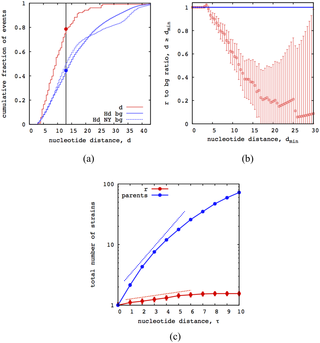PLoS Pathogens ( IF 5.5 ) Pub Date : 2017-11-07 , DOI: 10.1371/journal.ppat.1006685 Mara Villa , Michael Lässig

|
Reassortment, which is the exchange of genome sequence between viruses co-infecting a host cell, plays an important role in the evolution of segmented viruses. In the human influenza virus, reassortment happens most frequently between co-existing variants within the same lineage. This process breaks genetic linkage and fitness correlations between viral genome segments, but the resulting net effect on viral fitness has remained unclear. In this paper, we determine rate and average selective effect of reassortment processes in the human influenza lineage A/H3N2. For the surface proteins hemagglutinin and neuraminidase, reassortant variants with a mean distance of at least 3 nucleotides to their parent strains get established at a rate of about 10−2 in units of the neutral point mutation rate. Our inference is based on a new method to map reassortment events from joint genealogies of multiple genome segments, which is tested by extensive simulations. We show that intra-lineage reassortment processes are, on average, under substantial negative selection that increases in strength with increasing sequence distance between the parent strains. The deleterious effects of reassortment manifest themselves in two ways: there are fewer reassortment events than expected from a null model of neutral reassortment, and reassortant strains have fewer descendants than their non-reassortant counterparts. Our results suggest that influenza evolves under ubiquitous epistasis across proteins, which produces fitness barriers against reassortment even between co-circulating strains within one lineage.
中文翻译:

重组人流感的健身成本
重配是在共感染宿主细胞的病毒之间交换基因组序列,在分段病毒的进化中起着重要作用。在人流感病毒中,同一谱系中并存的变体之间发生重组的频率最高。这个过程打破了病毒基因组片段之间的遗传联系和适应性相关性,但是对病毒适应性的最终净效应仍不清楚。在本文中,我们确定了人类流感谱系A / H3N2中重排过程的速率和平均选择效果。对于表面蛋白血凝素和神经氨酸酶,以约10 -2的速率建立了与其亲本菌株平均距离至少3个核苷酸的重配变体以中性点突变率为单位。我们的推论基于一种从多个基因组片段的联合家谱中绘制重排事件的新方法,该方法已通过广泛的模拟进行了测试。我们显示,平均而言,沿袭的重排过程是在实质性的负选择下,其强度随着亲本菌株之间的序列距离的增加而增加。重配的有害影响以两种方式表现出来:与中性重配的无效模型相比,重配事件的发生少于预期,重配菌株的后代比非重配菌株的后代更少。我们的研究结果表明,流感病毒在蛋白质的普遍存在的情况下会进化,即使在一个谱系内的共同传播菌株之间,也能产生抵抗重组的适应性障碍。









































 京公网安备 11010802027423号
京公网安备 11010802027423号